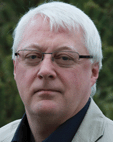DOI: 10.1039/C2CC90156K
(Profile)
Chem. Commun., 2012, 48, 5701-5702
Interview with Ed Constable
| ||||||
Do you remember what it felt like to publish your first ChemComm article?
Very much so. My first ChemComm (DOI:10.1039/C39800001065) concerned the results of my Part II project (equivalent to a Masters today) with Morrin Acheson in Oxford and was about the design and synthesis of linked acridines which could interact with DNA by intercalating at two different sites. This was the beginning of my love affair with heterocyclic chemistry and also my drive to work at the interfaces between chemistry and other disciplines.How has your research evolved from your first to your most recent article?
Most of my career has been spent working in coordination and supramolecular chemistry. I like to think that we were one of the first groups to recognize the potential of using the entire range of metals in the periodic table for directing the assembly of molecular fragments and designing functional systems. This has lead to our current emphasis upon sustainable materials chemistry and the design of complexes for use in photonic devices. We are lucky to have received an ERC Advanced Grant to support this work (Project Li–Lo: Light-in, light-out). I think that our most recent ChemComm exemplifies the areas that we are now working in (Light-emitting electrochemical cells based on a supramolecularly-caged phenanthroline-based iridium complex, DOI:10.1039/C0CC05084A).What do you like most about publishing in ChemComm?
There are many reasons why publishing in ChemComm is a special experience. Naturally the turnaround times and the impact factor play an important role. The free use of colour is also a great incentive, although I recall many bloody discussions on this topic in the Editorial Board in the 1990's. However, for me the overwhelming advantage is the professional and helpful editorial team.What aspect of your research are you most excited about at the moment?
I am genuinely excited by our work in developing sustainable technologies for lighting and light-harvesting. It hurts me to say it, because it concerns an element that has been at the heart of my research for much of my career, but the future is probably not ruthenium! We are actively studying the use of cheaper Earth-abundant metals of the first row of the transition metals for use as photosensitizers and emitters in various types of photonic devices.What is the best part of your job?
I love research and the possibility of making real contributions at a time in which society is forced to reassess its future structure in light of finite and diminishing resources. The dual challenge of doing research at the frontiers and being able to apply these results to “real-world” problems is the most exhilarating thing I can think of. Of course, the other part is the constant contact with young and highly talented scientists—the real rejuvenating effect of working in the University system. I also have the unusual pleasure of running the research group jointly with my wife, Catherine Housecroft, and so it really is a family affair.What is the secret to success in scientific publishing?
The primary secret is to have good, new and interesting results. But that is really only half of the story. The second part is to present these results in a simple and understandable manner. For me, the best response to my papers is “Gosh, that is so clever and yet so simple. Why didn’t I think of doing it?”What is your advice to young emerging scientists?
Stick at it. Listen to older scientists but if you think they are wrong, ignore their advice and do your own thing.What do you do in your spare time?
Yes, I remember spare time! Seriously, my real hobby is photography, particularly macro photography of insects and suchlike. In general, getting a few hours in the fresh air is a real pleasure and living in Switzerland, I have access to some of the most beautiful scenery in the world.By the time I'm 100 I would like to have ……
.....solved the World energy problem.| This journal is © The Royal Society of Chemistry 2012 |

